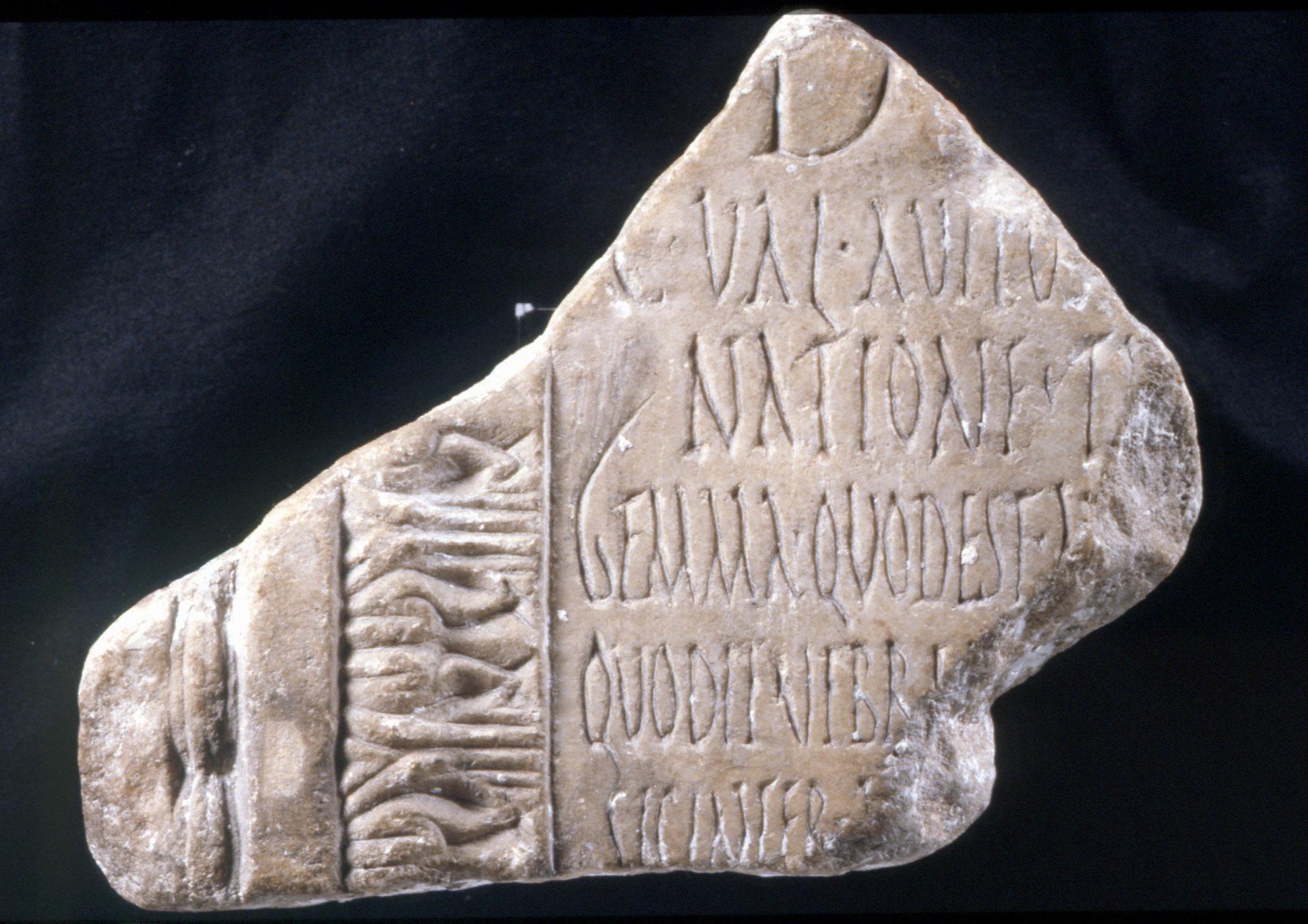Epitaph of Gaius Valerius Avitus
Reference CIL II 2253 = II2 / 7,394 | Description | Lyrics | Location | Chronology | Epigraphic edition | Translation | Apparatus | Comentary | Type of verse | Text divided into verses and metric signs | Images | Bibliography | Link to DB | Author |
Epitaph of Gaius Valerius Avitus
Description
- Idno filename 22/01/0083
- Type of inscription: Sepulcralis
- Material Description: White colour
- Conservation status: Fragmented at the left-hand part of the inscription
- Dimensions height/width/depth (cm): 20.5/27/6
-
Epigraphic field:
- Layout: Good "ordinatio". Triangular interpunctions (l. 2, dots) except after quod l. 4 and sic, l. 6.
- Epigraphic field dimensions hieght/weight (cm): 20.5/14
- Decoration: The writing field is delimited by a frieze with a border, fillet and broader band with plant decoration which "does not adopt any of the forms known in the repertoire of Roman repertoire of Roman architectural decoration of the first two centuries of our era: the leaves take on an almost abstract form, which is leaves take on an almost abstract form, which is highly improbable, not to say unthinkable, at a time when all the repertoires were perfectly systematised. at a time when all the repertoires were perfectly systematised."
- Preserved
Lyrics
- Font:Libraria
- Letter size:1, letters of 3,7; rest, 2/3; l. 4, G summa, 5 cm
- Description of the letters:Left-hand shaft of <N> truncated.
Location
- Place of discovery: Found in 1758 in Córdoba, "in the houses bordering Santa Marina cemetery" AYORA and RUANO apud STYLOW.
- Geolocation
- Conservation location: It was moved to the Huerta de los Aldabones, in Costanilla de San Lorenzo, where it was seen by PÉREZ BAYER and, in 1861, by HÜBNER L. MARAVER and ALFARO donated it to the M.A.N. in Madrid.
- Inventory number: 16834
- Location with Modern Nomenclature España / Córdoba
- Location with Old Nomenclature Hispania / Baetica / Cordubensis / Corduba
Chronology
- Inscription's dating: Between year 200 and year 299
- Dating explanation: In view of the paleography and the onomastic system, Stylow dated it to the end of the 2nd c. or beginning of the 3rd c. For the reasons mentioned above (type of moulding, metaphorical use of gemma), it is more likely to be 3rd c.
Type of verse
- Type of verse: Dactílico (hexámetro)
- Verse/line correspondence: Si
- Prose/verse distinction: Si
Epigraphic edition
D(is) [M(anibus) s(acrum)]
C(aius)▴ Val(erius) ▴ Avitus [‑ ‑ ‑]
natione ▴ T+[‑ ‑ ‑]
gemma ▴ quod est ▴ m[‑ ‑ ‑]
5 quod tenebrị [‑ ‑ ‑]
sic inter ▴ +[‑ ‑ ‑]
‑ ‑ ‑ ‑ ‑ ‑
Text divided into verses and metric signs
gemma quod est m[- – -] lkk|l/[n|ln|ln|lkk|l~]
quod tenebri [- – -] lkk|x[n|ln|ln|lkk|l~] or lkk|x[n|lUlkk|lkk|~]
sic inter [- – -] ll|x[n|ln|ln|lkk|l~]
– – – – – –
Translation
(Consecrated) to the gods (the Manes). Gaius Valerius Avitus, by birth[ ] Because he is the jewel[ ],because from the darkness[ ], thus among[ ]
Bibliography
M. J. de Ayora y Pinedo in epistula data ad López Cárdenas, quam Hübnner vidit solutam inter eius ms. 1765, et in Vázquez Venegas, ms. saec. XVIII, XII; Ruano 1762, I 183; Pérez Bayer, ms. 1782, 25 r.; Hübner 1860/61, 59–60 et II 2253 (Maraver 1863, 324 n. 83; de la Rada 1876, 273, del Rivero 1933, 55 n. 199); Haley 1986, 16 adn. 11, 104 n. 8 ex schedis Stylow (HEp 1993, 163); Stylow, II2/7, 394, cum im. phot., Fernández Martínez – Carande, CLEB, CO4, cum im. phot.; Cugusi 2012, n. 28. – Cf. Albertini 1912b, 309.
Apparatus
Litt. N to sinistra truncata v. 5.
3 natione · i Pérez Bayer, natione · ta Stylow. – 4 Cemna Hübner; quod est·A Stylow. – 5 quo die · febru Hübner, quod te(n)ebr++ Stylow. – 6 sis · inter · k Hübner, de la Rada, del Rivero.
Comentary
Carmen preceded by a praescriptum in prose (ll. 1-3). The beginnings of three verses,
dactylic hexameters or distichs, are conserved. Line 3 mentions the origin of the deceased, after
which is preserved a <T> and the remains of a second letter that Stylow identifies as an <A>,
proposing, along with Haley, the Lusitanian populus, Ta[porus]. However, it seems almost
certain that it is an <H>, in which case it is possible to infer a Thrax or Thracius (cf. Stylow
II2/7,24 natione Thracie); the concept of natio is usually broader, cf. Cagnat 1890, 63. Its
fragmentary condition makes interpretation difficult. In l. 4, Gemma could have a metaphorical
sense, as is usual in Christian poets and inscriptions, cf. CLE 1560B,3 and 688,8 (449 AD). L. 5
must refer to the darkness of death (cf. CLE 2131,3 and 503,2).
Author
- Author:R. Carande Herrero, C. Fernández Martínez
- Last Update2024-01-31 16:45:33
- Autopsy date:2001
You can download this





